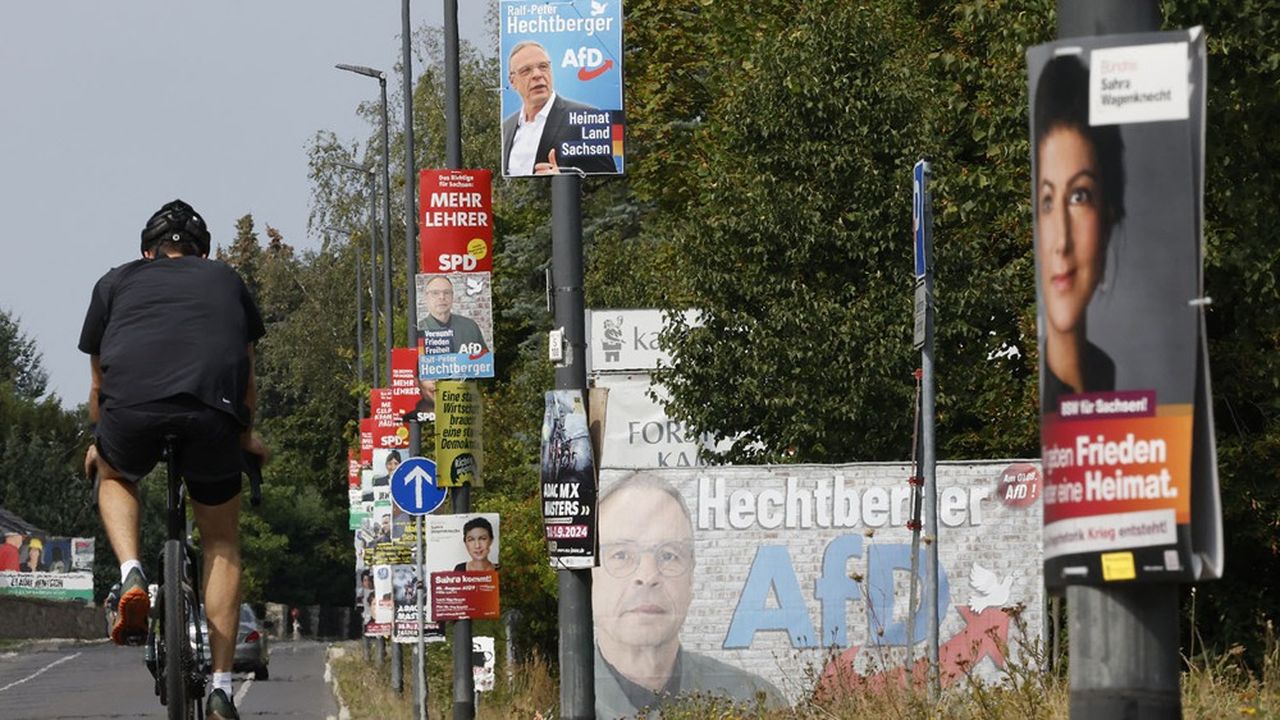
The warning was intended to be clear. “One thing must be remembered. Without the AfD, it will not be possible to form a stable majority,” Alice Weidel, co-chair of the far-right Alternative for Germany (AfD) party, insisted on Monday in the joint magazine of the television channels ARD and ZDF.
As the German far right has just won its first victory in a state since the Second World War, the results of Sunday’s regional elections raise questions about the evolution of German democracy and its role as a pole of stability in Europe.
On Sunday, the AfD won 32.8% of the vote in Thuringia, far ahead of the conservatives (23.6%), while it was close behind the conservatives in Saxony, with 30.6% of the vote. At the same time, a new far-left party, the Sahra Wagenknecht Alliance, is making its mark on the political scene, with double-digit scores (11.8% in Saxony and 15.8% in Thuringia).
Two lessons can be drawn from this situation. Basically, these elections mark a further fragmentation of the German political landscape. “The process of erosion of democratic parties in Germany continues to accelerate,” notes Uwe Jun, professor of political science at the University of Trier.
An elephant in the room
While in 1990 the country had two major parties, the Christian Democrats and the Social Democrats, which together could gather 77% of the vote, a supporting force (the Liberals) and two smaller parties (the Greens and Die Linke), things have changed significantly. Germany now has seven parties at the national level. The two major parties of the 1990s have lost influence and the extreme right has become the second largest force in the country in the polls.
This development is weighing on the functioning of the political system. “The increasing fragmentation of the German political landscape complicates the formation of coalitions, as well as their work. It then becomes difficult for a government to maintain a clear political line, which then creates discontent among voters,” explains Uwe Jun. A vicious circle.
The multiple quarrels that have poisoned the functioning of the coalition led by Olaf Scholz since 2021 are emblematic of this development. For a long time, the three parties only managed to reach an agreement thanks to the use of special extra-budgetary funds, which allowed the Greens and the Social Democrats to invest in the ecological transition and social issues, while guaranteeing the liberals respect for the dogma of the “debt brake”. When the Constitutional Court undermined this system in the fall of 2023, the three parties found themselves naked in the face of their differences.
Baroque coalitions
At the national level as in the regions, this fragmentation of the political landscape leads the parties to consider increasingly “baroque” coalitions. This is all the more difficult because there is an elephant in the room, the extreme right. And it is a question of avoiding at all costs that it enters a regional government.
In Saxony, the local Christian Democrats are considering working with the Sahra Wagenknecht Alliance, a pro-Russian and anti-immigrant party, which is campaigning for a halt to arms deliveries to Ukraine! Given the political positions of this party, this seems incredible. But the CDU has little choice if it wants to have a majority.
“If adults approach these issues in good faith and with the necessary measure of humility, and if they agree that the most important thing is the state and its people, then we can achieve a lot together,” Saxony’s Prime Minister Michael Kretschmer (CDU) said on ARD’s first channel on Monday. Sahra Wagenknecht said she would not enter into a coalition with a party that supported the installation of American long-range missiles on German soil. A statement that gives an idea of the difficulty of the upcoming negotiations.
A blocking minority
Second lesson from the elections: if the Länder of Thuringia and Saxony together only represent 7% of the German population, these two elections mark a victory for the extremes and a very strong dissatisfaction with the established parties.
Together, the German far right and the Sahra Wagenknecht Alliance managed to win 48.6% of the vote in Thuringia and 42.4% in Saxony. Above all, the far right will have a blocking minority in both Länder, which could, for example, allow it to block the renewal or appointment of constitutional judges.
For the AfD, this election may be an opportunity for an internal debate, after years of increasing radicalization. “The party will have to decide sooner or later whether it wants to govern or not. And with a radical model based on the ideas of Björn Höcke, this will work with great difficulty, if at all,” says Thorsten Faas, a political scientist at the Free University of Berlin.
The youth shift
The reasons for this rise of the extremes are multiple and touch on themes such as internal security, the economy or housing… In East Germany, the two parties have managed to seduce voters with their virulent discourse against immigration and their calls to put an end to arms deliveries to Ukraine.
In Thuringia and Saxony, the swing in the youth vote towards the far right is particularly striking. According to the polling institute Infratest Dimap, 38% of 18-24 year-olds voted for the far right in Thuringia, compared to 19% of those aged 70 and over. In Saxony, the proportion is 31 and 24% respectively. In both states, the AfD is the leading party among 18-24 year-olds.
The AfD’s success with young voters is probably linked to the ambient pessimism in Germany. Social networks, where the AfD is very present, also play a role. “It is also linked to the declining weight of the past. The young generation does not want to apologize for the mistakes of their great-grandparents and votes more relaxedly for the extreme right-wing parties,” says Uwe Jun. A worrying observation at a time when the country is mired in a kind of economic stagnation.





